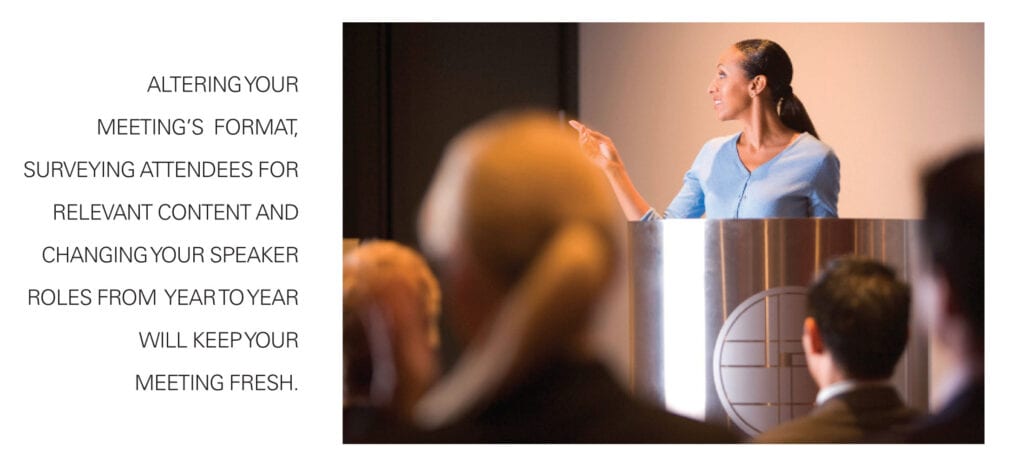Consider a “town hall meeting” concept to engage attendees.

For many organizations, annual meetings are an integral tool in communicating vision and future strategies. While it’s easy to keep these meetings fresh by changing the destination, creating new menus and hiring different entertainment year after year, it’s often more challenging to keep the meeting content from becoming stale. And while the message of the presentations is often crafted by its key stakeholders, it’s still the job of the meeting planner to apply strategic ideas that will raise the interest level of attendees.
The quickest way to change a meeting’s content is to alter the format in which it’s presented. Most meetings open and close with a general session on the first and last day with breakout sessions held in between. But rather than having your presenters “speak at” your attendees, develop conversational content that will glean feedback from the audience and then present solutions to their questions in the remaining days of the program. Similar to a “town hall meeting” concept, the general session is transformed into an interactive question and answer period where the organization’s key decision makers are able to learn the main issues facing their interest groups. Once the issues are revealed during this opening session, the speakers can then address solutions in the breakout sessions and provide a more comprehensive summary at the close of the meeting.
The key to establishing this type of meeting format is surveying your attendees in advance and finding out what hot topics
they want to see addressed. This prepares your speakers for questions and allows them to create presentations that will examine these topics in later sessions. It is important to select speakers who can develop a base presentation in advance and are willing and able to modify it based on the audience’s responses. If the speaker is a paid presenter, asking them to modify their presentation onsite could increase their fees. It’s often more cost effective to allow the paid speaker to create the base presentation and then use the organization’s non-paid executive speakers to modify the content for the breakout sessions.

When organizing a town hall meeting format, it’s also important to have a strong facilitator who can move the session efficiently from audience question to presenter answer without allowing the conversation to get bogged down on any one topic. The facilitator also takes note of the main issues that need to be further flushed out in the breakout sessions, which could require changes to the existing presentation material.
While it’s important to survey your attendees before the meeting to create relevant content for their needs, it’s equally as important to get their feedback at the end of the meeting to learn what worked and what should be changed for next year. While a written survey is the norm, try reserving a breakout session for a focus group and video tape the respondents to show at the next meeting. The group should be made up of a cross-section of your audience and include internal and external stakeholders.
This feedback is also important for the organization’s top executives who might be asked to present year after year. There is the challenge of a key manager whose presentation style is always stale even when the content changes every year. It’s often easier to give the head of an organization constructive criticism when it’s coming from a documented survey of members or internal stakeholders.
If the top executive is not willing to be coached or make changes to presentation style based on survey feedback, it’s best to allow the executive to introduce the main points of the meeting and then move on to a stronger presenter who can keep the audience engaged. While the top executive is still pitched as the keynote speaker in the meeting’s marketing materials, a paid presenter or another leader with a more engaging style can follow through with the top executive’s ideas in a more interactive way.
A paid speaker who is an expert in your field brings the added benefit of cutting-edge content. They can provide up-to-the minute content that is fresh and compelling. Well-known names can also attract a larger audience. While speaker bureaus can offer advice on the most engaging presenters who are relevant to your church or model, it’s still important to counter their ideas with your own research. The bureau may suggest a wellknown name, but this doesn’t mean they are the right fit for your community’s goals.
Another method of keeping speakers fresh is to rotate them in different presentation areas of the meeting. One year a speaker may moderate a panel discussion of topic experts and the next year sit on the panel and communicate their own expertise. It’s important to keep a presentation file that tracks each session topic and who presented the material. Refer to this file before planning the next meeting and ensure that speaker and material are varied and not duplicated from the previous year. This file should also include your audience survey so that you can cross-check your speaker’s results before deciding whether to include them as a presenter for the next year.
By following these three steps — altering your meeting’s format, surveying attendees for relevant content and changing your speaker roles from year to year — your meeting will remain fresh and engaging for participants.
Monica Compton, CMP, is an event specialist with Pinnacle Productions Inc. based in Atlanta. She has 17 years experience as a global meeting planner, managing a variety of programs both domestically and internationally.
